Have you ever wondered why some movies fill up your entire TV screen while others look squished? Or why a video may have black bars on the top and bottom or sides of your computer display, and other videos may not?
It’s because of an image property called an aspect ratio that determines its shape and dimensions. Every frame, digital video, canvas, responsive design, and image often has a rectangular shape that is exceptionally precise in proportion.
Many different aspect ratios have been used over the years. However, most consume digital video content in 16:9 and to some extent in 4:3. A typical high-definition TV, mobile device, and computer monitor use a 16:9 aspect ratio.
So what does aspect ratio mean exactly? The aspect ratio definition is the proportional relationship between the width and height of an image.
Two numbers separated by a colon represent the aspect ratio. The first number represents its width and the second for its height. For example, an aspect ratio of 1.78:1 means the image’s width is 1.78 times the size of its height. Whole numbers are easier to read, so this is often written as 4:3. This has nothing to do with the size of an image (but not the actual resolution or total pixels the image contains) – a 4000×3000 image and a 240×180 image have the same aspect ratios.
The dimensions of the sensor in your digital camera determine your default aspect ratio. It is based on the width and height (W: H) of the image. For example, if your camera sensor is 24mm wide and 16mm high, its aspect ratio would be 3:2.
Aspect ratio can be important for the very reason that there are so many standards. For example, as a filmmaker creating content for both mobile devices and PCs, you’ll have to account for the fact that a smartphone has a different aspect ratio than a laptop screen.
If you work with videos or pictures, you have to understand what aspect ratios are so you can quickly move videos, images and compress digital files/content from one screen to another without making an error in your calculations.
In the past, people didn’t need to know about aspect ratios. However, today we’re constantly surrounded by screens of different shapes and sizes, displaying a variety of footage. Therefore, it is helpful to understand the rules of film. Especially if you’re a creator. In this article, we’ll discuss aspect ratios in film and TV.
Films were often projected in 4:3 in the early days of cinema. Film strips commonly used these proportions. Due to this, everyone just went along with it. By shining light through it, you could project an image in the same aspect ratio.
In the silent movie era, the Academy of Motion Picture Arts and Sciences approved 1.37:1 as the optimal ratio in one of many attempts to standardize 1 aspect ratio. Therefore, the majority of films in theatres were presented in that aspect ratio.
In the 1950s, TV became more and more popular, and people started going to the theaters less, but the aspect ratios of theatres remained. As time passed, filmmakers began to tinker with the shapes and sizes of their frames, and aspect ratios began to change in response. Up until the early 2000s, TV boxes were all 4:3, so there was no confusion on what the aspect ratio should be.
Things changed when widescreen high-definition television became popular. New technology forced older shows to convert their 4:3 shows to 16×9 to stay in circulation. This was done either by cropping movies to fit a screen or techniques known as letterboxing and pillarboxing.
Letterboxing and pillarboxing are methods for preserving a film’s original aspect ratio when it is shown on a screen with a different ratio. When there is a discrepancy between capture and display aspect ratios, black bars appear on the screen. “Letterboxing” refers to the bars at the top and bottom of the screen. They appear when the content has a wider aspect ratio than the screen. “Pillarboxing” refers to black bars on the sides of the screen. They occur when the filmed content has a taller aspect ratio than the screen.
Modern television sets maintained this wider ratio. Also allowing for widescreen film formats that allow movies to be expressed in their original format.
There have been many different aspect ratios throughout the history of film and television, including:
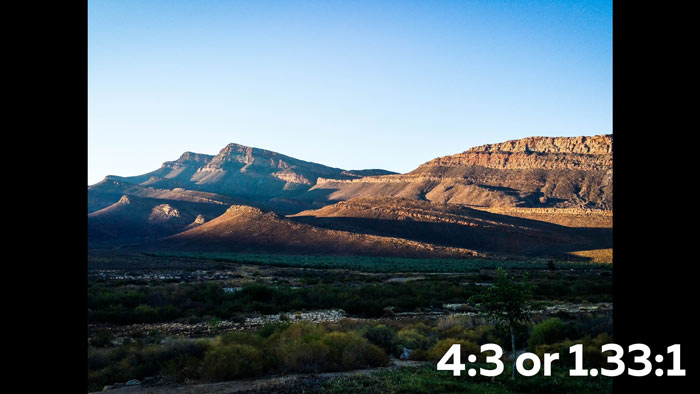
In the past, all TV screens were 4:3. Before widescreen television, most videos were shot at the same aspect ratio. It was the very first aspect ratio for TV sets, computer monitors, and all screens at the time. Making it one of the most common aspect ratios. Consequently, fullscreen became its name.
You’ll find that older videos are of a square image than videos today. Movies at the theatre divested from the 4:3 ratio relatively early, but television sets remained in that ratio until the early 2000s.
This ratio serves little purpose other than nostalgia-based artistic indulgence in the modern era. Zack Snyder used this technique in Justice League (2021). MCU show WandaVision also used this technique as a way to pay homage to the early days of television.
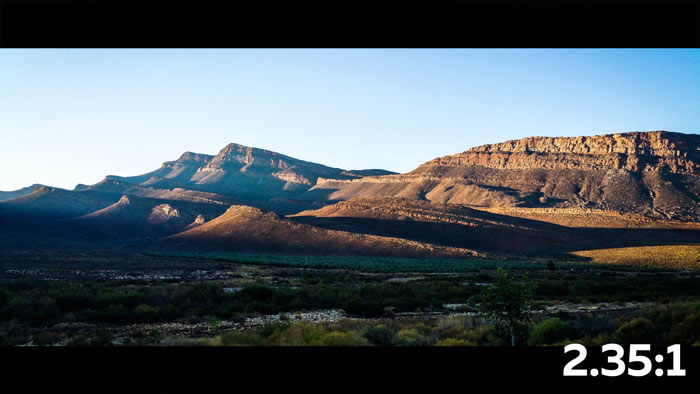
At some point, movie makers decided to expand the aspect ratio of their movies. This was based on the observation that human vision is much wider than 4:3, so film ought to accommodate that experience.
This resulted in the creation of super widescreen formats involving three standard 35mm film cameras that simultaneously projected a film onto a curved screen. The technique was called CineScope. The aspect ratio revitalized cinema.
CineScope delivered novel ultra-wide imagery that was a spectacle during its time. It was a radical change from the previous standard aspect ratio of 4:3. Most audiences had never seen anything like it. With it, widescreen took over and forever altered the way videos were filmed.
It was common for frames to be distorted, and faces and objects sometimes appeared fatter or wider. But it was insignificant at the time. However, its reign didn’t last long as it was moved on for less expensive means. The first animated movie released in this format was Lady and the Tramp (1955).

The most common aspect ratio used today is 16:9. It has become the standard ratio for most screens, from laptops to smartphones. Also known as 1.77:1/1.78:1. This aspect ratio was developed in the 1980s and ’90s but was not widely adopted until the mid-2000s.
It gained popularity in 2009 as a midpoint between the 4:3 and CineScope. Its rectangular frame allowed for both 4:3 and widescreen content to fit comfortably within its field. This made it easy for movies with other aspect ratios to be comfortably letterboxed or pillarboxed. It also causes minimal warping and distortion of images when you crop a 4:3 or 2.35:1.
Most viewers watch content on 16:9 screens. So shooting in this ratio is always a good idea. Although, this does not include movies as they are filmed in 1.85 (and some in 2.39).
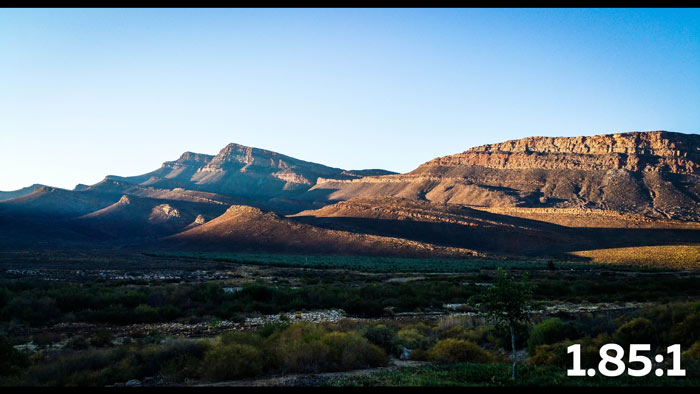
The standard widescreen format in cinema is 18.5:1. It is pretty similar in size to 16:9, although a little wider. Though most common for feature films, many TV shows striving for a cinematic look also shoot in 1.85:1. There is some letterboxing when displayed outside of a theatre, but since this shape fits well, the bars at the top and bottom are pretty small. Some European countries have 1.6:1 as the standard aspect ratio for widescreen.
The 1.85 widescreen aspect ratio is known for being taller than the others. This makes it the choice ratio for videos that intend to focus on characters and longitudinal objects. For example, 1.85:1 is the aspect ratio of Greta Gerwig’s Little Women (2020).
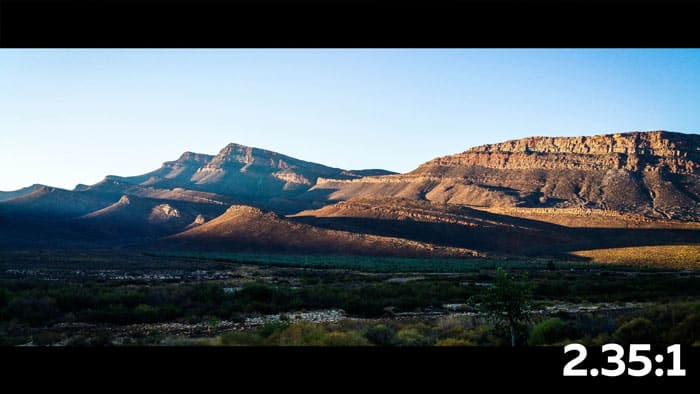
In modern cinemas, 2.39:1 remains the widest aspect ratio. Popularly called the anamorphic widescreen format, it creates an aesthetic customarily associated with premium dramatic feature films. Its wide field of view makes it the ratio of choice for shooting landscapes as it provides more detail. In addition, it remains popular among wildlife documentaries, animations, and comic book movies.
During World War I, France developed the first anamorphic lenses. They provided a wider field-of-view for the crews of military tanks. However, this level of complexity is no longer relevant as modern digital cameras are capable of emulating different dimensions at will. Recently, Blade Runner 2049 used a 2.39:1 aspect ratio.
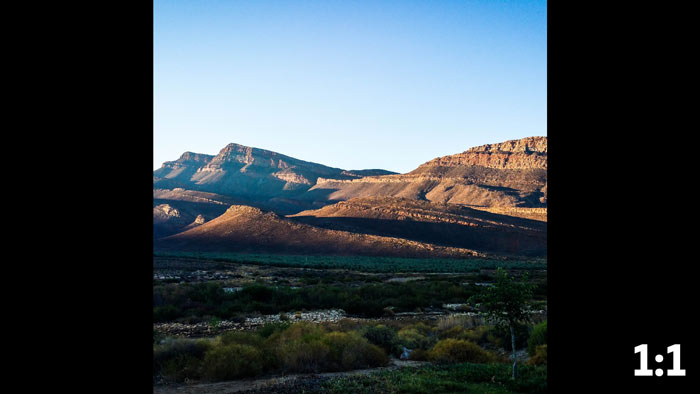
A 1:1 aspect ratio is also known as the square format. 1:1 is, of course, a perfect square. Some medium-format cameras utilize this format.
Although rarely used for film and movies, it gained popularity when Instagram adopted it as its default aspect ratio at its 2012 launch. Since then, other photo-sharing social media apps adopted the ratio, including Facebook and Tumblr.
However, social media platforms are becoming more adapted for wider aspect ratios. The default aspect ratio is again shifting to 16:9. Almost all Instagram stories and reels are shot in 16:9. In addition, cameras and apps are becoming more friendly to traditional film aspect ratios.
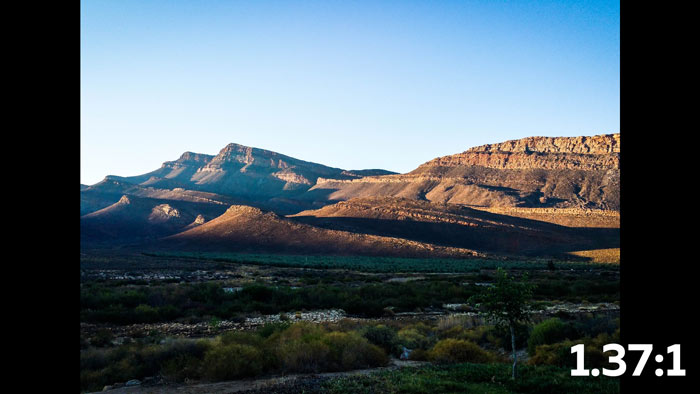
At the end of the silent era in 1932, the Academy of Motion Picture Arts and Sciences standardized the film aspect ratio to 1.37:1. This was only a slight deviation from the aspect ratio of silent films. This was done in order to accommodate a soundtrack on a reel without creating a vertical frame.
In modern filmmaking, this technique is rarely used. Yet, a few years ago, it appeared in The Grand Budapest Hotel. Director Wes Anderson used 1.37:1 alongside two other aspect ratios to represent three different periods of time.
An image sensor on a camera sets the default aspect ratio for a video. Modern cameras, however, allow you to choose different aspect ratios at will, which is a real asset to filmmakers.
Choosing the aspect ratio to use mainly depends on the makeup of your camera as well as the type and purpose of the videos you want to make. For example, shooting panoramic landscapes demands a wide field of view which 16:9 and other widescreen ratios are more suited for. On the other hand, if you’re shooting for Instagram, you’ll need to shoot in 1:1. However, if you’re unsure, the best bet is to shoot in 16:9.
The widescreen aspect ratios are best for video since they are wider than they are tall. With 16:9, you can fit more in your frame horizontally while being able to adjust to common aspect ratios quickly. While the 4:3 aspect ratio is still prevalent in still photography because it’s better for printing, it has been less popular in filmmaking for a while.
Cropping videos can cause a drop in quality, so if you intend to change aspect ratios often, it makes sense to use a full-frame camera for your filming needs. This way, you can crop your photo and still retain its quality and not worry about the noise, grain, and distortion that comes with resizing.
Many filmmakers tinker with different aspect ratios for mainly creative reasons. In order to remain practical, they may shoot in a “safe” aspect ratio that will reduce the amount you’ll need to crop later on.
When you shoot your photo or video in an aspect ratio that doesn’t match the platform it’s on, you may end up cropping or distorting the image.
Videographers may need to change the aspect ratio of a video through cropping. For example, Clideo.com crop tool allows you to change the aspect ratio after the video has been taken. It even lets you specify the exact dimensions of your video if you don’t want any of the traditional aspect ratios. It also has social media presets that allow you to adjust the aspect ratio of your video to that of whatever platform you want. As you change your aspect ratio, it is essential to remember that different formats affect the makeup and the size of your image, so always exercise some caution.
You may have encountered aspect ratio many times. Yet, likely, you will never have to take it seriously until you start filming. Aspect ratio is an essential variable for anyone trying to film. They determine how people consume your films and how they engaged with them.
If you need to resize a photo or video to adjust to a different display or platform, it is essential to know what is an aspect ratio and the types and uses. Now that you won’t need to ask yourself: what does aspect ratio mean. You’re ready to decide which aspect ratio you’ll want to use. We hope to have helped you decide which one is right for you.